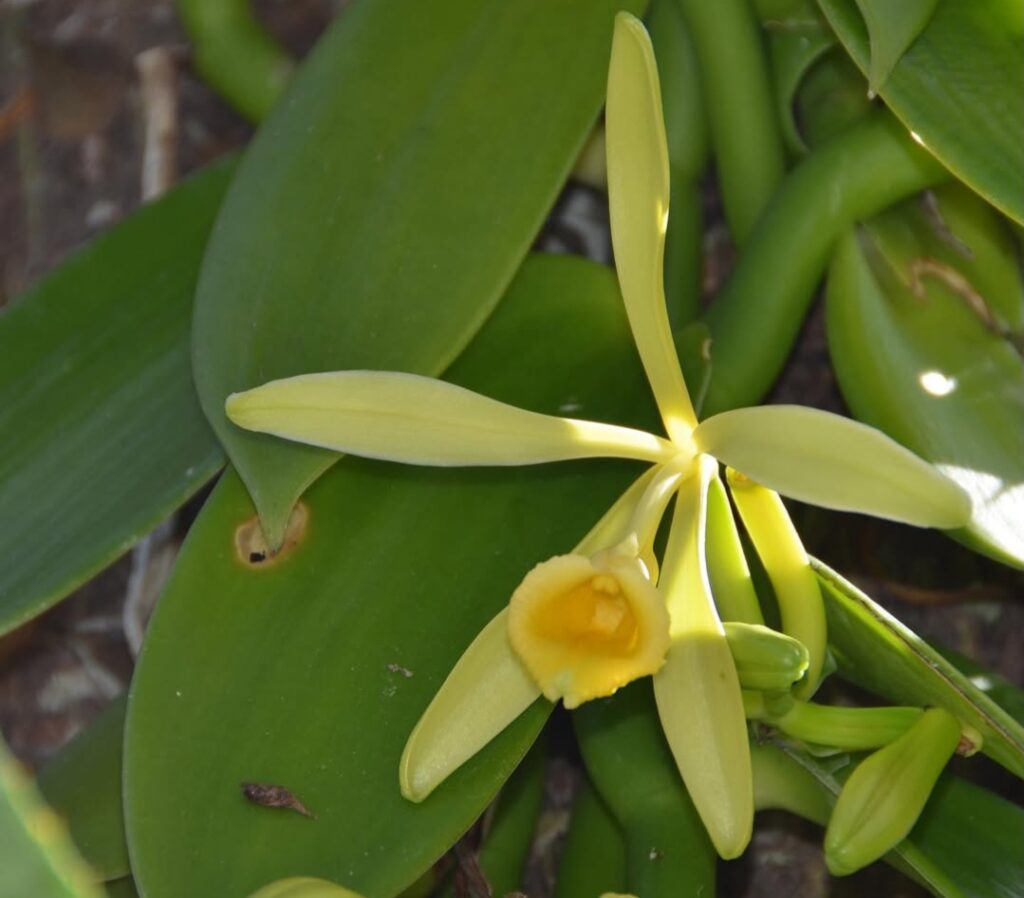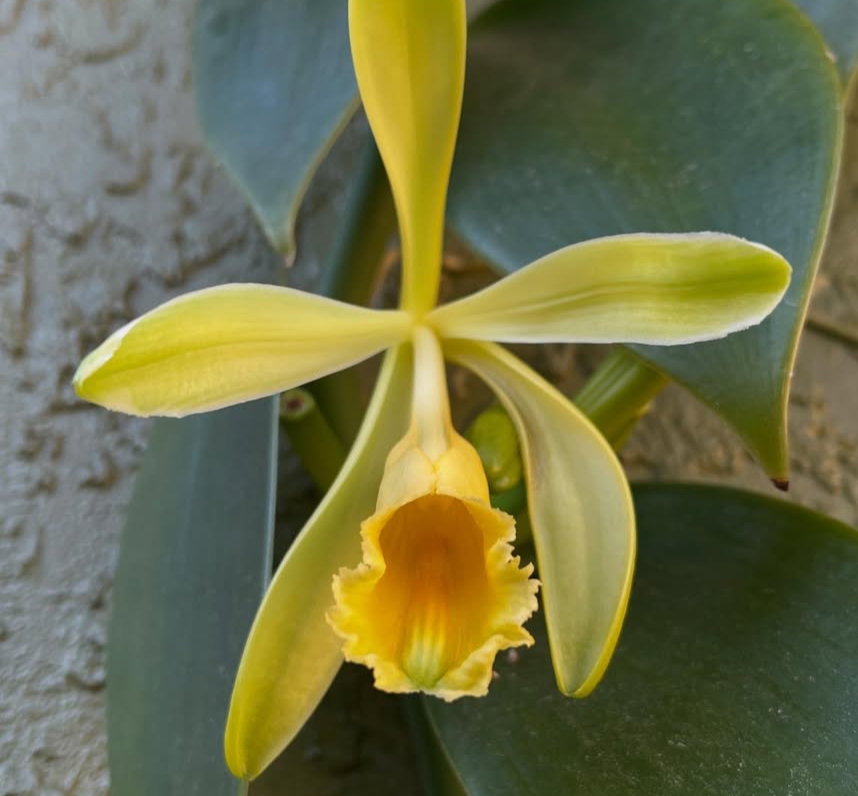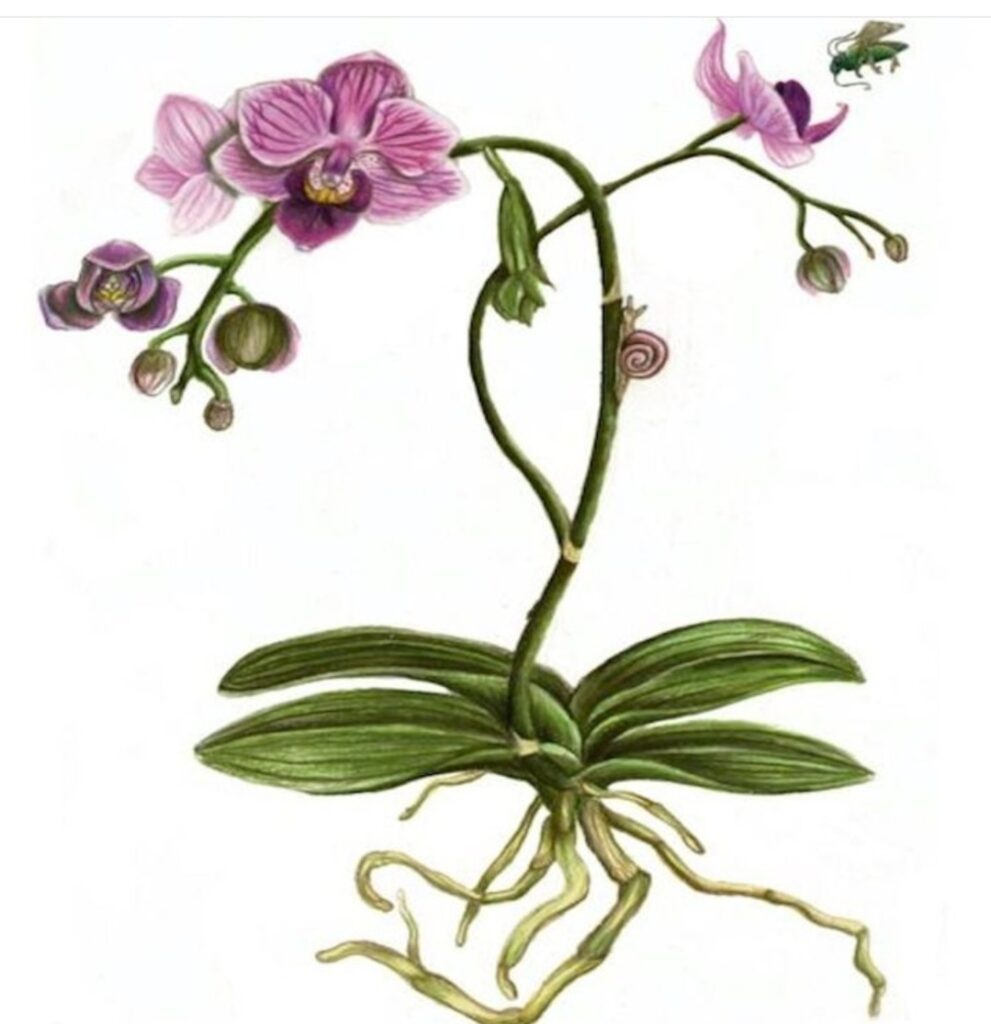Vanilla isn’t just a favorite flavor in desserts—it’s also a living, climbing orchid known as Vanilla planifolia, a tropical beauty that brings both charm and challenge to any plant lover’s collection. When it comes to Vanilla Orchids Care, this unique plant stands out from your typical Phalaenopsis or Cattleya, as it demands space, patience, and the right conditions to thrive and eventually reward you with something truly special: real vanilla beans. But don’t worry—while growing vanilla orchids might sound like a task best left to professionals, it’s absolutely possible to cultivate this fascinating plant at home with the right guidance.
Native to the warm, humid forests of Central and South America, Vanilla planifolia is a fast-growing vine that can stretch over 30 feet in its natural environment. It climbs using aerial roots and produces striking green leaves along its thick, fleshy stem. Given the right conditions, it will surprise you with delicate green-yellow blooms that are not just beautiful, but also hold the key to pollination and eventual bean production. However, this process doesn’t happen overnight—it’s a slow, steady journey of nurturing, training, and understanding your orchid’s unique needs.
Whether you’re dreaming of harvesting your own vanilla beans one day, or simply fascinated by the idea of growing one of the world’s most sought-after spices, this guide will walk you through the most important steps. From creating the perfect environment to mastering pollination and vine management, we’ll cover everything you need to know to grow a healthy, thriving Vanilla planifolia.
So, if you’re ready to transform your home or garden into a tropical vanilla paradise, let’s dive into the 7 best tips to grow Vanilla planifolia successfully—and unlock the secrets behind this extraordinary orchid.

Vanilla orchids varieties
There are over 100 different species of vanilla orchids, but the most commonly cultivated varieties for commercial use are
Vanilla tahitensis: This variety is native to French Polynesia and produces a floral and fruity flavor with notes of cherry and licorice.
Vanilla pompona: Also known as West Indian vanilla, this variety is native to the Caribbean and South America. It produces a strong, smoky flavor with hints of spice.
Vanilla mexicana: This variety is native to Mexico and produces a delicate flavor with floral notes.
Vanilla odorata: Also known as the fragrant vanilla orchid, this variety is native to Central and South America. It produces a sweet and floral flavor with notes of fruit
.Vanilla sambac: This variety is native to Southeast Asia and produces a unique flavor with hints of jasmine and other floral notes.
Vanilla phaeantha: This rare variety is native to Madagascar and produces a distinctive spicy flavor with hints of cinnamon and clove.
Growing vanilla orchids in pots
Choose the right pot: Vanilla orchids require a lot of space for their roots, so choose a pot that is at least 12 inches wide and 12 inches deep. Make sure the pot has good drainage holes.
Choose the right soil: Vanilla orchids prefer well-draining soil that is rich in organic matter. A mix of orchid bark, perlite, and peat moss is ideal. You can also add some charcoal to the mix to help with drainage.
Plant the orchid: Fill the pot with the soil mix, leaving about an inch of space at the top. Remove the vanilla orchid from its current pot and gently loosen the roots. Place the orchid in the new pot and fill in the gaps with soil. Make sure the base of the plant is level with the soil surface.
Water the orchid: Vanilla orchids require regular watering, but they do not like to be logged. Water the orchid when the top inch of soil feels dry to the touch. Make sure to water the pot thoroughly and allow the excess water to drain out of the pot.
Provide the right growing conditions: Vanilla orchids prefer bright, indirect sunlight and warm temperatures between 60 and 80 °F. They also prefer high humidity, so consider placing a humidifier or a tray of water near the plant. You can also mist the plant with water occasionally.
Fertilize the orchid: Vanilla orchids require regular fertilisation to grow and produce flowers. Use a balanced orchid fertiliser every 2-3 weeks during the growing season (spring and summer) and reduce the frequency during the dormant season (fall and winter).
Train the orchid: Vanilla orchids are climbing plants, so you may need to provide some support. You can use a stake or trellis to help the orchid climb. Gently tie the stems to the support with some twine or plant ties.With proper care and attention, your vanilla orchid should grow and bloom beautifully in its pot.
Pruning of Vanilla orchids
Pruning of vanilla orchids is an essential aspect of their care and maintenance. Here are some tips on how to prune vanilla orchids:
Prune after harvesting: Vanilla orchids are typically pruned after harvesting the vanilla beans. The stems that have produced the beans should be cut back to a point just above the next leaf node.
Trim dead or damaged stems: Inspect the plant regularly and remove any dead or damaged stems. Cut them back to the point where healthy tissue be
Maintain a tidy appearance: Prune any wayward stems to maintain a tidy appearance. Cut them back to a point just above a leaf node.
Control the plant’s size: If the plant becomes too large for its growing space, prune it back to a manageable size. Be careful not to remove too much of the plant’s foliage as this can slow down growth.
Use clean tools: Always use clean, sharp pruning tools to prevent the spread of disease.
Propagating of Vanilla orchids
Cuttings from the stem: Choose a section of the orchid’s stem that has at least two or three nodes. The little bumps on the stem known as nodes are where the leaves sprout. Leave one or two leaves on the top node and remove the leaves from the bottom node or nodes. Plant the cut end in a well-draining potting mix after dipping it in rooting hormone. The cutting should start to root and thrive after a few weeks if you keep the soil warm and moist.
Air layering: Choose a healthy stem and make a small incision on the stem, about an inch below a node. Wrap damp sphagnum moss around the cut, and cover it with plastic wrap or aluminum foil. Keep the moss moist and wait for roots to grow from the node. Once roots have formed, cut the stem below the moss and pot it up in a well-draining potting mix.Note that Vanilla orchids can be slow-growing and can take several years to mature and produce flowers, regardless of the propagation method used. It is important to be patient and provide the orchid with proper care, including regular watering, fertilization, and adequate light.
Common Pests and Diseases and their solutions
Vanilla orchids are susceptible to a variety of pests and diseases, which can negatively affect their growth and development. Here are some common pests and diseases of vanilla orchids and their solutions:
Mealybugs: Mealybugs are small, soft-bodied insects that feed on plant sap and leave a sticky, honeydew-like substance on the plant. They can be controlled by spraying the plant with insecticidal soap or neem oil.
Thrips: Thrips are tiny, slender insects that feed on the plant’s leaves and flowers, causing distortion and discoloration. They can be controlled by spraying the plant with insecticidal soap or neem oil.
Spider mites: Spider mites are tiny, spider-like pests that suck the sap from the plant’s leaves, causing yellowing and stippling. They can be controlled by spraying the plant with a mixture of water and neem oil.
Black rot: Black rot is a fungal disease that causes black, sunken spots on the plant’s leaves and stems. It can be controlled by removing infected plant parts and applying a fungicide.
Anthracnose: Anthracnose is a fungal disease that causes dark, sunken spots on the plant’s leaves, stems, and pods. It can be controlled by removing infected plant parts and applying a fungicide.
Fusarium wilt: Fusarium wilt is a fungal disease that causes the plant to wilt and die. It can be controlled by removing infected plant parts and applying a fungicide.
Bacterial leaf spot: Bacterial leaf spot is a bacterial disease that causes water-soaked spots on the plant’s leaves, which turn brown and fall off. It can be controlled by removing infected plant parts and applying a bactericide.
To prevent pests and diseases in vanilla orchids, it is important to maintain good growing conditions, including proper watering, adequate sunlight, and appropriate fertilizer. Regular monitoring and inspection of the plants can also help catch and treat pests and diseases early.
Harvesting of Vanilla orchids beans
Vanilla orchids are primarily grown for their flavorful beans, which are used in cooking, baking, and flavoring. Harvesting of vanilla orchids is a delicate process that requires expertise and patience
The vanilla orchid blooms once a year, and each flower lasts for just one day. In order to produce the vanilla bean, the flower must be pollinated within this 24-hour period. This is typically done by hand, using a thin stick or needle to transfer pollen from the anther to the stigma of the flower.
The vanilla beans start to grow after the blossoms have been pollinated. These beans must be closely watched while they mature, which takes several months. The beans can be harvested when they are fully grown.
Harvesting of vanilla orchids typically involves carefully picking the mature beans by hand. The beans are then washed and blanched to stop the enzymatic process that causes them to ripen further. They are then placed in the sun to dry, a process that can take several weeks.
During the drying process, the beans must be regularly turned and sorted to ensure that they are drying evenly and that any damaged or spoiled beans are removed. Once the beans are fully dried, they can be packaged and shipped to market.
Harvesting of vanilla orchids is a labor-intensive process that requires skilled workers and careful attention to detail. However, the resulting beans are highly prized for their unique flavor and aroma, making the effort worthwhile.
blooming of Vanilla orchids
Bloom vanilla orchids refer to the process of flowering of vanilla orchid plants, which is necessary for the production of vanilla pods. Vanilla orchids are tropical plants that require specific growing conditions, including warm temperatures, high humidity, and filtered sunlight.
The blooming process of vanilla orchids is a delicate and intricate one that requires special care and attention. The flowers of vanilla orchids only bloom for one day, and they need to be pollinated during this time to produce the vanilla pods. The pollination of vanilla orchids is typically done by hand, which requires a great deal of skill and patience.
After the flowers of the vanilla orchid are pollinated, they will eventually develop into long, slender pods that contain the vanilla beans. These pods take several months to mature and must be carefully harvested and cured to produce high-quality vanilla extract.
Overall, blooming vanilla a complex process that requires specific growing conditions and careful attention to detail to produce the coveted vanilla pods used in cooking and baking.
Common Issues in vanilla orchids
Vanilla orchids are prized for their fragrant, flavorful pods, which are used to produce vanilla extract. However, these plants can be quite challenging to grow, and there are several common issues that can arise. Here are some of the most common issues in vanilla orchids
Root rot: Vanilla orchids are susceptible to root rot, which is caused by overwatering or poor drainage. If the roots of the plant are continuously wet, they can become infected with fungi and bacteria, which can cause the roots to rot and eventually kill the plant
Pests: Common pests that can affect vanilla orchids include spider mites, mealybugs, and thrips. These pests can damage the leaves and flowers of the plant and weaken the plant overall.
Nutrient deficiencies: Vanilla orchids require a balanced supply of nutrients to thrive. A lack of nutrients can cause stunted growth, yellowing leaves, and a lack of flowering.
Incorrect pruning: Pruning is important for maintaining the shape and size of the plant, but it should be done carefully. Over-pruning can damage the plant and inhibit its growth, while under-pruning can lead to a messy and unattractive appearance.
Improper support: Vanilla orchids require a sturdy support structure to grow on, as their vines can become quite heavy. If the support is inadequate, the plant can become damaged or even fall over.
Environmental factors: Vanilla orchids require specific environmental conditions to thrive. They prefer warm, humid conditions and bright, indirect light. If these conditions are not met, the plant may struggle to grow and produce flowers.
Growing Vanilla planifolia may not be the quickest or easiest orchid to cultivate, but it’s undeniably one of the most rewarding. From its lush, tropical vines to the potential of producing your own vanilla beans, this plant offers a truly unique gardening experience. With patience, the right environment, and the 7 tips we’ve covered, you’ll be well on your way to nurturing a healthy, vigorous vanilla orchid that can thrive for years.
Remember—success with vanilla orchids doesn’t come overnight. But if you treat your plant with care, stay consistent with its needs, and enjoy the process, you’ll soon see why this orchid has captivated growers around the world. Whether you’re growing it for its stunning appearance or dreaming of harvesting homemade vanilla, every step you take brings you closer to something extraordinary.
Now it’s your turn—start climbing with your vanilla orchid, one beautiful root and leaf at a time.
FAQ
What is Vanilla Orchids Care and why is it important?
Vanilla Orchids Care refers to the specific attention and conditions needed to grow healthy Vanilla planifolia vines. Proper care ensures the plant thrives and produces vanilla beans.
How much light is ideal for Vanilla Orchids Care?
Bright, indirect light is best for Vanilla Orchids Care. Direct sunlight can scorch the leaves, while too little light can stunt growth and prevent flowering.
What type of soil should I use for Vanilla Orchids Care?
For effective Vanilla Orchids Care, use a well-draining mix—typically orchid bark, perlite, and sphagnum moss—to mimic tropical conditions.
How often should I water under Vanilla Orchids Care guidelines?
Water moderately. Vanilla Orchids Care involves keeping the soil slightly moist but not soggy. Let the top inch dry out before watering again.
Is humidity important in Vanilla Orchids Care?
Yes, high humidity (above 60%) is essential for Vanilla Orchids Care. Consider using a humidifier or misting regularly to maintain moisture.
Can Vanilla Orchids be grown indoors with proper care?
Absolutely. With proper Vanilla Orchids Care, you can grow Vanilla planifolia indoors using a support structure and by ensuring warm, humid conditions.
What temperature range supports optimal Vanilla Orchids Care?
Vanilla Orchids Care requires warm temperatures—ideally between 70°F and 85°F during the day and not below 60°F at night.
How long does it take to get vanilla beans with Vanilla Orchids Care?
With consistent Vanilla Orchids Care, it may take 3–5 years for the plant to mature and produce flowers that can be pollinated for beans.
Do I need to hand-pollinate my vanilla orchid?
Yes. For successful Vanilla Orchids Care, hand-pollination is usually required as the natural pollinators aren’t present in most areas.
What kind of support is needed in Vanilla Orchids Care?
Vanilla orchids are vines. A trellis, pole, or moss stick is essential for Vanilla Orchids Care to allow the plant to climb and develop well
Can I propagate my plant as part of Vanilla Orchids Care?
Yes, propagation is a part of Vanilla Orchids Care. Cuttings with at least 2–3 nodes can be rooted in moist media and grown into new vines.
What are signs of poor Vanilla Orchids Care?
Yellowing leaves, no growth, or root rot can all signal poor Vanilla Orchids Care. Adjust watering, light, and humidity accordingly.
Should I fertilize as part of Vanilla Orchids Care?
Yes, monthly feeding with a balanced orchid fertilizer is recommended in Vanilla Orchids Care to support strong vine and root development.
Can pests affect Vanilla Orchids Care?
Yes. Watch out for mealybugs and spider mites. Regular inspection and treatment are vital parts of Vanilla Orchids Care.
Is pruning necessary for Vanilla Orchids Care?
Occasional pruning improves air circulation and encourages growth, making it a helpful step in consistent Vanilla Orchids Care.




